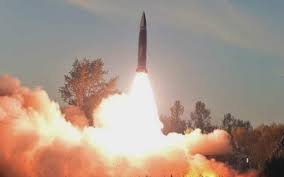
SEOUL, May 8 (Yonhap): North Korea launched multiple short-range ballistic missiles (SRBMs) into the East Sea early Thursday morning, marking the regime’s sixth missile test of the year. The missiles were fired from the eastern coastal city of Wonsan between 8:10 a.m. and 9:20 a.m. local time, according to South Korea’s Joint Chiefs of Staff (JCS).
The Missile flew approximately 800 kilometers before splashing down in the sea, South Korean and Japanese military officials confirmed. While Japan reported that the missiles posed no immediate threat to its territory, both Seoul and Tokyo condemned the launch as a clear violation of United Nations Security Council resolutions.
Military analysts and officials in Seoul believe the test may have been aimed at verifying the performance and flight stability of weapons intended for export, particularly to Russia. South Korean defense spokesperson Col. Lee Sung-jun stated, “It could be a test to inspect performance or flight stability for possible exports.” North Korea has reportedly exported the KN-23 and KN-25 missiles—both types believed to be involved in Thursday’s launch—to Russia. The KN-23 resembles Russia’s Iskander missile and is known for its low-altitude and maneuverable flight path.
The Korea Institute for National Unification’s analyst Hong Min speculated that Pyongyang may be using battlefield data from the Russia-Ukraine war to enhance missile durability and accuracy. U.S. and allied intelligence agencies have long accused North Korea of supplying weapons to Moscow, claims both Pyongyang and the Kremlin deny. However, South Korea recently accused North Korea of dispatching thousands of combat troops to the Russian frontlines in the Kursk region—its most explicit acknowledgment of direct military involvement to date.
The latest launch comes just a week after North Korea tested weapons systems aboard its newly unveiled 5,000-tonne warship, the Choe Hyon, which it claims is outfitted with the “most powerful weapons system” to date. Seoul suspects the warship’s construction involved Russian assistance, potentially in exchange for North Korean military support in Ukraine. The two nations also announced the construction of their first cross-border road link, further signaling deepening ties.
Tensions continue to escalate in the Korean Peninsula. The North has previously used joint U.S.-South Korea military drills such as March’s Freedom Shield exercises as justification for weapons testing, branding them as “provocative invasion rehearsals.” In contrast, Washington and Seoul maintain that these drills are purely defensive.
Despite refraining from major provocations like intercontinental ballistic missile launches this year, Pyongyang continues to develop its arsenal aggressively. Leader Kim Jong-un has made recent factory visits to inspect tank and munitions production and is reportedly continuing engine tests for a potential military spy satellite, though no imminent launch appears likely.
The South Korean military has condemned the missile tests as a “blatant provocative act” and vowed to maintain a robust defense posture to deter further aggression. With four ballistic missile tests already conducted in 2025, North Korea shows no signs of scaling back its military ambitions amid growing strategic cooperation with Russia.




